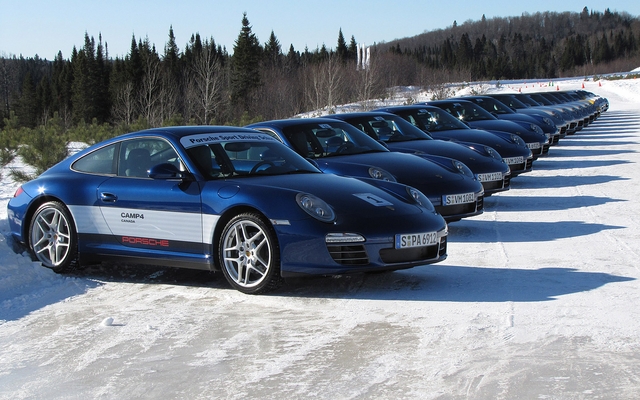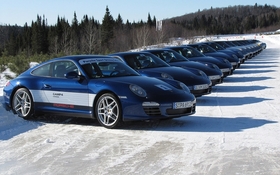Porsche Camp4 Canada: Crash course in deluxe winter driving
When you love to drive and are passionate about cars, there’s no refusing an offer to ride in a Porsche. Not even in the wee hours of a winter morning when The Weather Network warns that it’s 24-below outside at Mont-Tremblant. The day before the course, two dozen automobile columnists and journalists, myself included, headed to the swanky Fairmont Hotel to take part in a condensed version of Camp4 Canada, the first winter driving course offered in our country by Porsche.
In Europe, this program has existed for years already and three levels are offered: Precision, Performance and Master. Naturally, the degree of difficulty and the speed of the exercises increase as you progress through the courses, each being a prerequisite for the next. Porsche made its first foray into North America in 2007, with a course held in Vail, Colorado.
The climate, the atmosphere and the circuit
This time, the manufacturer chose the Laurentian Mountains, based on guaranteed winter conditions, the comfortable amenities at Mont-Tremblant and the easy access from La Macaza and Montreal Trudeau airports, as participants would be coming from Toronto, New York and elsewhere.
Of course, Porsche also opted for the Tremblant area because of its proximity to the Mecaglisse Motorsports Complex in Notre-Dame-de-la-Merci. Franck and Vincent Kirchhoff know all about winter driving and meticulously maintain the kilometers of snow and ice tracks. These tracks can be combined any way you like, including a circular drifting area. For Camp4, they doubled the pleasure with two circles creating a large figure-8 circuit.
The Precision program was offered to the general public and took place over three days. This included two full days of driving exercises at Mecaglisse. The package also included three nights at the Fairmont Hotel, three breakfasts, two lunches at Mecaglisse and three suppers. Most meals were group affairs.
To join, you don’t have to own a Porsche, but a thick wallet or a bulletproof credit card is advisable as the registration fee for this first edition was $4,995. This buys you almost two full days at the wheel of one of the 25 sports cars that Porsche brought from Germany by boat.
It’s still expensive though, despite the cars. There’s the cushy hotel, the good food and the luxurious bus that shuttled participants between the hotel and the track. There are other, cheaper winter driving programs out there, but Porsche is Porsche. You don’t become the most profitable manufacturer on the planet by accident or by being charitable.
Precision tools provided
Everything went off without a hitch at Camp4. Kai Riemer, the head instructor of the European program, came from Germany to keep an eye on things. He was surrounded by locally-based assistants and instructors, including Franck Kirchhoff, who called the shots for the group that I was in for the day. Automobile columnist and pilot Bertrand Godin was my teammate.
We drove different cars for different exercises, namely 911 Carrera 4S Coupe, a 911 Carrera 4 Cabriolet and a Cayman S Coupe. The first two have a rear engine and all-wheel drive, while the third has rear-wheel drive and a central engine. All of the cars have slightly studded Nokian Hakkapeliitta 7 snow tires. Because of the rough ride we’d be giving the tires, Porsche had 1-mm quadrangular head studs added to the normal configuration.
For the European course, Porsche prefers tires without studs for the Precision level, but after Kai Riemer’s first visit to Mecaglisse, he came away convinced that its tracks were too icy for that. Good thinking. The Hakkapeliitta 7 provided the amount of traction needed for runs almost entirely covered in ice that was made extra hard by frigid temperatures.
Calling all studs
These tires are a long way from the studded tires that my teammate used when he raced at the Challenge de Sherbrooke. Bertrand would later say that it’s harder to drive a Porsche on an icy track with studded tires designed for the road than to drive a 450-hp ultralight T3F race car with studded tires.
For the Performance course, the second level of the program, the tires were fitted with 1.5-mm studs. And for the Master level, ice-devouring 4 mm studs were used.
Graduates of this first Camp4 Canada will be eligible to sign up for the Performance program that, for now, is only offered at the Porsche Driving Centre in Ivalo, Finland. It costs €4,350 (or $5,860 at the current exchange rate) and you’d have to spend €5,490 ($7,395) this year for the Master level. On the other hand, the first level costs only €2,090 ($2,814) over there, whether you take it in Lungau, in the Austrian Alps, or in Rovaniemi, Finland. Porsche does not plan on offering the two more advanced levels on this side of the Atlantic for now.
Slip-sliding away
My group’s first exercise was a seemingly easy straight-line slalom. But on the ice and at the wheel of a 385-hp Carrera 4S Coupe, that’s easier said than done, even with studded tires and all-wheel drive. On my first attempt, the PDK gearbox shifted into second right away. I was already going too fast for the slick ice and my bumper tapped the second orange cone, just like one of the very green beginners who went ahead of us.
The blow to my pride was offset somewhat when Bertrand hit a cone too. We had fun in the C4 S trying to get a feel for the anti-skid system in Sport Plus mode. This system controls engine speed and torque, but it can’t perform miracles when traction is next to nil.
When the PSM is completely deactivated, driving becomes a matter of smoothness, finesse and anticipation. Always look far ahead, that’s the first commandment of driving. And since the engine is mounted above the rear axle, actuation is strong in a 911. This means you use the accelerator to fishtail, but once the tail end begins to drift, all that overhanging weight pulls it to the outside of the turn.
The number of spin-outs increased with the degree of difficulty, and our group was now doing the second portion of the exercise with higher speeds, longer turns and trail-braking. It was a similar scenario for the drift circle, this time at the wheel of a 345-hp Carrera 4 Cabriolet.
Soon we were drifting in a continuous loop. The 911 was almost at a right angle with all four wheels skidding. This large figure-8 is where I totally redeemed myself from my earlier mistakes with a near-perfect second lap. I swear, it’s true...
With my honour nearly restored, we moved to the third and final exercise of our condensed program. We did laps on an undulating course with an additional slalom behind the wheel of a 320-hp Cayman S. The weaker actuation of this rear-wheel drive vehicle is largely offset by the balance that its centrally positioned engine affords it.
Under the control of my fingertips, the Cayman performed with finesse, with long drifts as we climbed and came out of curves. It was a nice way to finish the day, with our senses heightened and leaving us feeling more in tune with the limits of traction that we reached – or surpassed – in a fraction of a second on the ice.
Meeting winter head-on
This program would have been unthinkable a little more than 20 years ago. Porsche launched its first four-wheel drive 911 in 1989 and then added more sophisticated electronic control systems, beginning with ABS brakes and then the PSM stability control. Not to mention that the brand was the first to offer a 10-year warranty against body perforations.
The Camp4 program makes it clear that you can drive a Porsche in winter, even without all-wheel drive and even with the stability control disengaged. All you need is a good set of tires, with or without studs, and definitely with an alert driver who is prepared for anything and in complete control.
That’s the lesson we learned from all those pirouettes on the ice; no matter how much experience or skill the driver may have, an antiskid system is a valuable ally when you’re behind the wheel of a Porsche. But its electronic prowess will never replace vigilance, anticipation and driving smoothly in cold weather when ice is a threat. Otherwise, the ice will win, guaranteed.
Heading back home in the compact that I was test driving that week, I felt more relaxed and my driving was more accurate. You might even say I was a better driver. You can’t take an advanced driving course without improving. And you certainly can’t come away without a big smile across your face.












